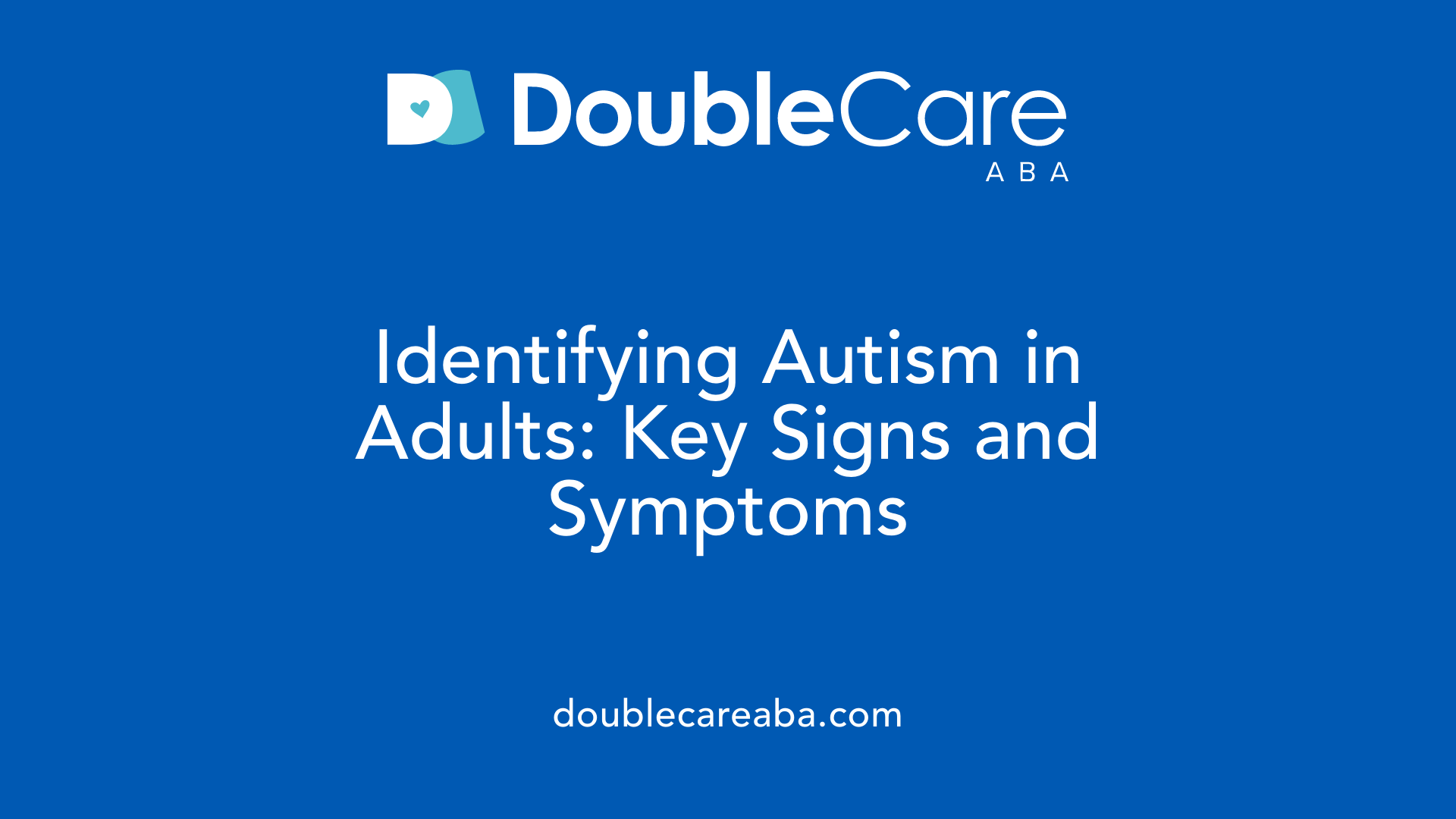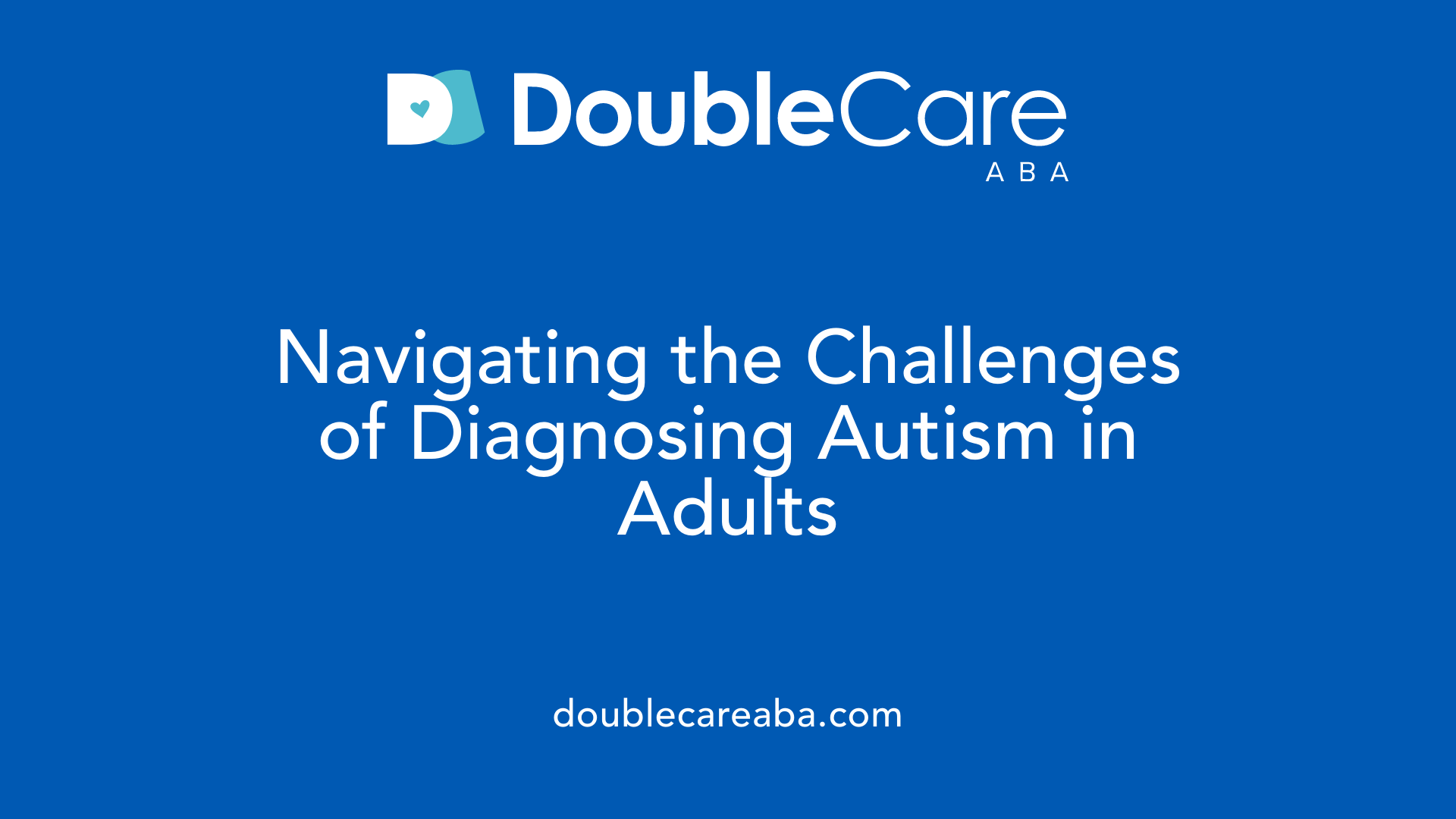The Hidden Challenges of Autism in Adulthood
Autism Spectrum Disorder (ASD) is often recognized in childhood, but many adults live with autism symptoms that go undiagnosed or misunderstood. Adult autism presents unique challenges and signs that can differ from those typically seen in children. This article explores the common signs and symptoms of autism in adults, highlights diagnostic complexities, and provides insights into effective therapeutic approaches, including Applied Behavior Analysis (ABA) therapy. Understanding these facets is crucial for improving recognition, support, and treatment outcomes for autistic adults.
Recognizing Signs and Symptoms of Autism in Adults

What Are the Common Signs of Autism in Adults?
Adults with autism often face difficulties in social communication, such as understanding others' thoughts and feelings and maintaining friendships. They may feel social anxiety and prefer solitude or display seemingly blunt or uninterested behavior. Communicating emotions can be challenging, and they might take language very literally.
Social Communication and Nonverbal Challenges
Difficulty with nonverbal communication is common. Autistic adults may avoid eye contact or feel uncomfortable with physical proximity. They often struggle with interpreting facial expressions, body language, sarcasm, and idioms. Speech might lack typical inflection, further affecting social interactions.
Restricted and Repetitive Behaviors
Many adults exhibit repetitive actions like arranging objects methodically or making involuntary noises. They often rely on routines and experience distress when these are disrupted. Intense, focused interests can lead them to discuss specific topics extensively, sometimes reflecting strengths in areas like math, science, or the arts.
Sensory Sensitivities
Hypersensitivity to sensory stimuli—such as sounds, lights, textures, or smells—is frequent and can cause discomfort or anxiety. This sensory overload may result in withdrawal or distress in daily environments.
Differences Between Adults and Children
While the fundamental autism traits are similar, adults typically experience milder symptoms or mask them through coping strategies. Social anxiety and difficulty making conversations may become more apparent with age.
Gender Differences in Autism Presentation
Autistic women often appear quieter, use subtle coping strategies, and show fewer repetitive behaviors, which can obscure diagnosis. They may consciously or unconsciously hide signs to better fit in socially.
| Aspect | Description | Examples/Notable Details |
|---|---|---|
| Social Communication | Challenges understanding and expressing social cues | Difficulty with friendships, social anxiety, literal interpretation |
| Nonverbal Communication | Issues with eye contact, body language | Avoidance of eye contact, trouble reading emotions |
| Repetitive Behaviors | Preference for routines and repetitive actions | Arranging items, involuntary noises, distress if routines change |
| Sensory Sensitivities | High or low sensitivity to sensory input | Distress from loud sounds or bright lights |
| Adult vs. Child Presentation | Milder or masked symptoms in adults | Use of coping strategies, social anxiety more pronounced |
| Gender Differences | Variations in symptom expression | Women may hide signs, fewer repetitive behaviors |
Social Communication and Interaction Challenges in Adult Autism

How do autism-related social and communication difficulties manifest in adults?
Adults with autism spectrum disorder often face challenges navigating social interactions, stemming from difficulties understanding social rules and nuances. Many find grasping sarcasm, idioms, or figurative language particularly confusing, leading to misunderstandings.
Interpreting nonverbal cues such as facial expressions and body language is another common difficulty. For example, discomfort or distress during eye contact is frequent, and some may speak with a flat tone lacking typical inflection. These struggles can make initiating or maintaining conversations hard.
Social anxiety often accompanies these challenges, causing adults to prefer solitude or avoid situations that require intense social engagement. To manage, some autistic adults develop masking behaviors—consciously hiding their symptoms to blend in and cope within social environments.
Impact on personal relationships
These social communication difficulties can significantly affect forming and sustaining friendships or other personal relationships. Misunderstandings, difficulty reading emotions, and challenges with social reciprocity may lead to feelings of isolation or being perceived as uninterested or blunt by others.
Adults may also prefer rigid routines and solitary activities, which can limit shared social experiences. Understanding these challenges fosters greater empathy and helps tailor support strategies to improve social inclusion and quality of life for autistic adults.
Restrictive, Repetitive Behaviors and Intense Interests in Adults with Autism

What are rigid routines and why do adults with autism prefer them?
Many autistic adults rely heavily on structured and predictable routines. Changes to these routines can cause significant distress and discomfort. This preference helps create a sense of stability and reduces anxiety brought on by unpredictable or unfamiliar situations.
What kinds of repetitive movements and vocalizations are common?
Autistic adults often engage in repetitive behaviors such as hand-flapping, rocking, or making involuntary noises. These actions can serve as self-soothing mechanisms or ways to cope with overwhelming sensory experiences.
How do intense interests manifest in adults with autism?
Intense focus on specific topics or hobbies is a hallmark trait. Individuals may talk at length about these interests, displaying deep knowledge. Such topics can range widely, including areas like mathematics, art, science, or music.
What strengths can arise from these special interests?
Special interests can foster strengths and talents. For example, an autistic adult's passion for a scientific topic might lead to excellence in research, or a focus on art could result in creative achievements. These interests often offer a sense of purpose and motivation.
Do autistic adults seek or avoid sensory inputs?
Sensory experiences play a significant role, with many showing hypersensitivity or hyposensitivity to stimuli such as sounds, lights, textures, or smells. Some may seek sensory inputs that provide comfort, while others avoid overwhelming sensations to maintain emotional balance.
The Complexities of Diagnosing Autism in Adults

How is autism diagnosed in adults?
Diagnosing autism in adults is a nuanced process that involves multiple clinical appointments. These sessions typically include detailed conversations about the individual's history and current challenges, cognitive activity-based tests, structured behavioral observations, and questionnaires that assess social communication skills. Unlike in children, there are no standardized screening tests specifically designed for adults, which complicates the assessment.
Why are some signs of autism harder to detect in adults?
Many adults with autism develop coping mechanisms, often referred to as "masking," which allow them to hide or modify symptoms to fit social expectations. This masking, combined with generally milder symptoms, can make autism less noticeable during evaluations. Additionally, autistic women frequently exhibit subtler signs, such as being quieter or showing fewer repetitive behaviors, further challenging diagnosis.
What does the evaluation process involve?
Professional evaluations are performed by trained clinicians such as psychologists or psychiatrists. The process includes collecting comprehensive information through interviews, clinical observations, and cognitive assessments. Tools like the ADOS-2 may be used to guide behavioral observations, but clinicians rely heavily on judgment due to variability in symptom presentation.
Why is obtaining a formal diagnosis important?
Receiving a formal autism diagnosis opens access to vital support services, legal protections like those offered under the Americans with Disabilities Act (ADA), and specific vocational assistance. Moreover, it helps individuals understand their behaviors better, allowing them to focus on strengths and seek suitable treatments or resources.
How do gender differences impact autism diagnosis?
Gender plays a significant role in diagnosis rates. Autistic women often mask their symptoms more effectively, show fewer repetitive behaviors, and cope better in social settings, which can result in delayed or missed diagnoses. Recognition of these gender differences is essential for improving diagnosis accuracy.
What barriers exist to adult autism diagnosis?
A lack of awareness about adult autism, limited access to specialist services, and the absence of standardized adult screening tools pose significant barriers. Many adults remain undiagnosed due to these factors, as well as unclear symptom recognition by healthcare providers unfamiliar with adult presentations of autism.
Applied Behavior Analysis (ABA) Therapy: Foundations and Benefits for Autism

What is Applied Behavior Analysis (ABA) therapy and how does it help individuals with autism?
Applied Behavior Analysis (ABA) therapy is a scientific, evidence-based method designed to improve social, communication, and daily living skills for people with autism. It operates by analyzing behaviors through the Antecedent-Behavior-Consequence (A-B-C) model, which studies the triggers (Antecedents), the behavior itself, and its outcomes (Consequences).
ABA principles and methods
ABA therapy uses personalized strategies such as positive reinforcement to encourage desired behaviors. Techniques include prompting to guide learners and teaching skills in natural environments to promote real-world application. This personalized approach ensures that therapy meets the unique needs of each individual with autism.
Scope of skills addressed through ABA
The therapy covers a wide range of skills:
- Communication and language development
- Social interaction and relationship building
- Self-care and adaptive daily living tasks
- Academic learning
All these areas contribute to greater independence and quality of life.
Individualized therapy plans and role of positive reinforcement
Each ABA therapy plan is tailored to the individual's strengths and challenges. Positive reinforcement—rewarding desired behaviors—plays a central role in motivating progress and reducing unwanted behaviors.
Measuring progress and outcomes
Progress is carefully tracked by trained professionals through observations and data analysis. This ensures therapy adjusts as needed and delivers measurable improvements in behavior and skills.
ABA therapy's structured, data-driven, and compassionate approach makes it a cornerstone in autism support, fostering skill development and meaningful independence.
Who Provides ABA Therapy and Their Qualifications

Who Typically Provides ABA Therapy and What Qualifications Do Professionals Need?
ABA therapy is delivered by a team of qualified professionals specialized in applied behavior analysis. The primary providers include Board Certified Behavior Analysts (BCBAs) and Board Certified Assistant Behavior Analysts (BCaBAs). These individuals obtain their credentials by completing specialized graduate-level coursework combined with supervised, practical experience, and then passing rigorous certification exams. This formal training ensures that they are equipped to develop and oversee individualized, evidence-based treatment plans tailored for people with autism.
Behavior therapists and technicians also play a vital role in ABA therapy. While they may not hold BCBA or BCaBA certifications, they receive intensive training to implement ABA techniques under the guidance and supervision of certified behavior analysts. Their hands-on work enables consistent application of interventions and ongoing progress monitoring.
The involvement of qualified providers is crucial for achieving effective treatment outcomes. Certification signifies a professional's competency in understanding autism spectrum disorder and designing behavioral interventions that are ethical, systematic, and measurable. Proper training and supervision help maintain treatment fidelity and maximize the benefits for individuals receiving ABA therapy.
Common Techniques Used in ABA Therapy for Autism

What are the common techniques used in ABA therapy for autism?
Applied Behavior Analysis (ABA) therapy utilizes several specialized techniques to support skill development and behavior management in individuals with autism.
Discrete Trial Training (DTT) breaks down complex skills into small, manageable steps. Each step is taught through repeated trials, where correct responses are reinforced, building proficiency gradually.
Natural Environment Teaching (NET) focuses on teaching skills in everyday settings. This approach promotes generalization by embedding learning in natural routines and play activities.
Pivotal Response Treatment (PRT) targets pivotal areas such as motivation and response to multiple cues. Enhancing these pivotal skills helps produce widespread improvements in communication and social behaviors.
Verbal Behavior Interventions concentrate on improving communication, addressing functional language use, requesting, and social exchanges.
Additional strategies include:
- Prompting and Fading: Providing cues to encourage correct responses, then gradually reducing support.
- Behavior Chaining: Teaching complex tasks by linking simple actions into a sequence.
- Modeling and Redirection: Demonstrating appropriate behaviors and guiding attention.
All these methods rely heavily on positive reinforcement, rewarding desired behaviors to encourage their recurrence. Progress is carefully tracked through data collection, ensuring that therapy remains effective and tailored to the individual's needs. This structured yet flexible approach fosters meaningful and lasting skill acquisition across diverse settings.
Evidence, Criticisms, and Considerations Regarding ABA Therapy

What evidence supports the effectiveness of ABA therapy in treating autism?
Applied Behavior Analysis (ABA) therapy is widely supported by scientific research as an effective intervention for autism spectrum disorder (ASD). Numerous studies and meta-analyses have demonstrated that ABA improves critical areas such as communication, social skills, and adaptive behaviors. When delivered early in life and tailored to an individual's needs, ABA can lead to significant gains in IQ, language ability, and social functioning. It also helps reduce challenging behaviors and emotional difficulties, with many individuals exhibiting sustained improvements over time.
Are there any criticisms or limitations associated with ABA therapy?
Despite its proven benefits, ABA therapy has faced a range of criticisms and limitations. Its intensive and repetitive nature can sometimes cause emotional distress or burnout in the person receiving therapy. Ethical concerns include the historic use of punitive techniques and a focus on compliance that may suppress individuality and self-expression. While modern ABA prioritizes positive reinforcement and ethical practice, some advocates argue that a one-size-fits-all approach risks overlooking neurodiversity and personal preferences.
Balancing effectiveness with respect for individuality
ABA therapy has evolved significantly from its early, more rigid applications. Contemporary models emphasize person-centered care that respects the autistic individual's unique strengths and needs. Incorporating neurodiversity perspectives encourages flexibility in treatment goals, aiming not only to reduce problematic behaviors but to enhance quality of life and support self-advocacy. Successful ABA programs balance rigorous evidence-based methods with compassionate approaches that honor the diverse experiences of autistic individuals.
Supporting Autistic Adults Through Recognition and Tailored Interventions
Recognizing the signs and symptoms of autism in adults is vital for providing timely support and improving quality of life. Autism manifests uniquely in each individual, with challenges in social communication, restrictive behaviors, and sensory sensitivities shaping their experiences. Diagnosis remains complex, often complicated by masking and subtle symptoms, yet is essential for access to services and self-understanding. Among effective treatments, ABA therapy stands out as a well-researched method that promotes skill development and independence when delivered by qualified professionals using individualized approaches. Awareness of both its benefits and criticisms encourages continued refinement of interventions that honor neurodiversity and personal autonomy. Through comprehensive recognition, diagnosis, and personalized support, adults on the spectrum can thrive in their communities and lead fulfilling lives.
References
- Signs of autism in adults
- Autism in adults: Signs, symptoms, and diagnosis
- Treatment and Intervention for Autism Spectrum Disorder
- Autism diagnosis as an adult
- Autism Spectrum Disorder (ASD)
- The Signs of Autism in Adults and the Types
- Signs that a child or adult may be autistic
- Concerns About ABA-Based Intervention: An Evaluation and ...
- Is ABA Therapy Harmful?
- Ethical Concerns with Applied Behavior Analysis for Autism ...














